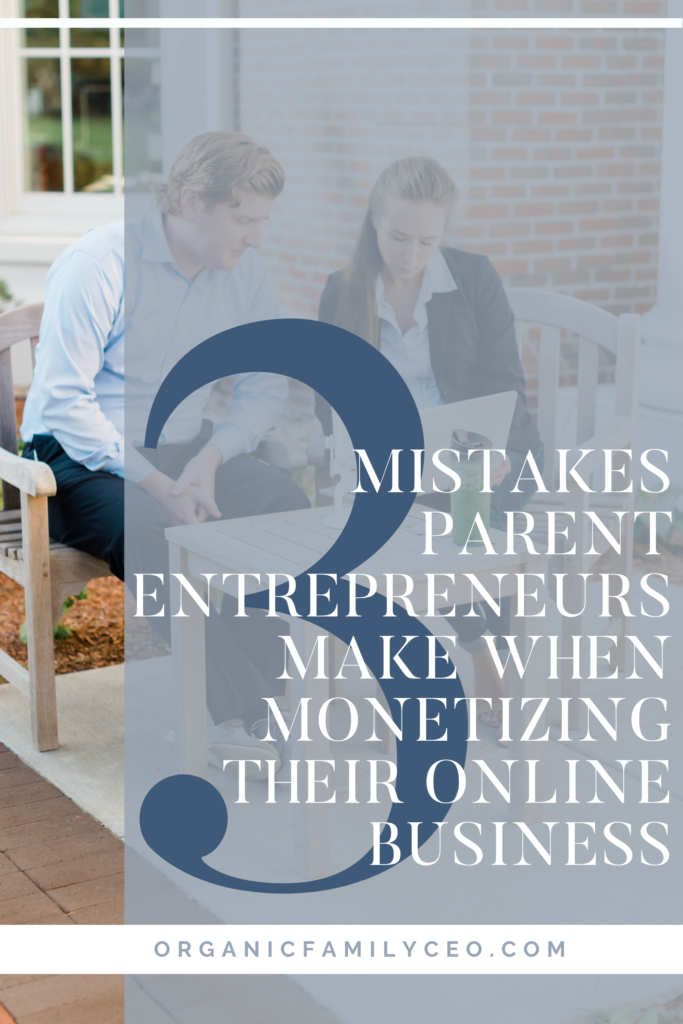Ever wonder “How do I make my online-based business consistently profitable?
In our consulting business for parent entrepreneurs with online-based businesses, we get this question often. Many online-based business owners experience the feast-and-famine cycles between product launches + seasonal promotions. You’re so not alone if you’re simply over hearing that “this is just a slow season” + you’re ready for a more consistent entrepreneurial paycheck.
To start to answer this question, we’re starting out with an example:
Think about setting a goal to lose more weight: the ingredients are the same regardless of the tactics implemented. In all scenarios — no matter what program we follow (or don’t follow) — we have to: exercise, eat healthy + stay consistent. Simple, right? Almost too simple.
After a week of no results, we’re likely to start getting impatient. We might start trying crazy diets for 30 days, lose weight + then gain all the weight back when the diet ends. Or maybe we take supplements to “get GAINZ” only to lose them all after going off the supplements.
The bottom line is this: there are healthy ways to lose weight that can sustainably last a lifetime… And for every one of them, there are a million unhealthy ways to lose weight that might give short-term gains, only to then fall away in the long run.
We’re encouraging you to start thinking that way about your business. How can you monetize your business in a healthy way that will last the long term? How can you “lose the weight” + run a lean, profitable business all year round?
Well, to start, you can avoid these 3 mistakes that take your business down the unhealthy route.
Let’s get started!

No. 1 — Pricing for Volume
Pricing products + services well is a big ingredient when it comes to monetizing a business.
Here are a few reasons why:
- Your price sets the market for your product.
Think Ferrari vs. Honda. Ferrari is in the luxury car market that is targeting a very specific group of financially-qualifying customers. Their high pricepoint is a large part of the reason why the brand is more exclusive.
Honda sells cars at a much lower price point which is appealing to a broader market for being more affordable.
- Your price sets your company’s operating ability.
The more profit you make, the more cash you have to invest back into your business. You can do this by hiring a team, implementing technology or doubling-down on advertising, to name a few ways.
The more profit you make, the more cash you have to invest back into your business.
- Your price also determines your company’s financial well-being.
When your income is greater than your expenses, you’re financially fit.
Income > Expenses = Financial Fitness
The price of your product drives your income. Get the price wrong + this formula can flip, putting your business in a difficult position financially.
With all of these important results tied to this one key ingredient, pricing is a TOP place where entrepreneurs stumble.
There’s so much pressure tied to pricing — some, if not most, of which we alone put on ourselves. This comes in different forms such as limiting thoughts like “no one is going to want to pay for this”.
Maybe we’re not paying attention to the right financial metrics which could help us avoid what could be a quick fix because we’re intimidated by math or feel like there’s not enough money to go around.
The possibilities for pricing pressure are endless.
What can often happen is that many parent entrepreneurs will cave + price for VOLUME — meaning setting a price that they think will get the most customers in the door (even if that’s not their intended business model). They’ll lower their price super low or overdeliver with extra bonus deals, giveaways + other incentives to earn the sale.
Why is this a problem?
Because you can’t base your price only on what will get the most customers in the door — or ANY customers in the door — without first considering what it costs to produce the product (or service) you’re selling in the first place.
If your product costs $100 all said + done to make, ship, package + promote your paper planner but you set its price at $50 in your online store because you think that’s what will sell more planners, you are actually losing $50 every sale. Not sustainable.
Instead, price to make a profit. Take the time to identify your operating costs + resources (like your TIME) + then price accordingly.
Take another look at the example from before except now price for profit. Setting the price at $150 — knowing that the costs are $100 — gives you a profit of $50 every sale. Now you have a sustainable business.
The same goes for offering client incentives → if you’re trying to make your product stand out in a sea of similar products (or even the exact same product if you’re distributing product like in the social selling industry), but you’re gifting more bonuses than your profit can cover just to make the sale, then you’re actually running a charity. ????
No 2. — Mismanagement of Resources
Mismanaging resources is not specific to online-based entrepreneurs. Nearly every traditional corporate startup in the history of startups struggles with managing resources. Whether it is burning through cash, expanding into too many markets, or hiring the wrong people, managing resources can be difficult.
So why can mismanaging resources be a death blow specifically to parent entrepreneurs?
There are so many reasons.
For one, we don’t have an endless supply of cash flowing in via fundraising efforts like business loans or venture capital.
A company like Amazon was able to weather the storm for years because they had an endless supply of investors throwing cash into the system to keep the business running. A high cash burn rate was offset by a high investment rate.
As parent entrepreneurs running family-centered businesses, managing our resources is critical to success. Once the money is gone… it is gone. Once our time is gone… it is gone, too. And this is applied at home just as much as it is at work.
And here’s what’s especially risky about that: it’s now not just you who suffers the loss. Your family loses, too.
We’re not dealing with monopoly money. This is real-deal, food-on-the-table money + the meaningful memories of the time you spend with your kids as mom or dad.
Here are 3 ways to manage resources + make your investments work for you:
- Simplify your business plan.
Leave the grand business plan at the door. If you cannot afford to hire help or invest in a system, then simplify the plan so that YOU can run the business yourself. Then expand when the money is there.
Having a team does not mean someone is running a profitable business. We’re huge advocates of bringing your partner into the business strategically — consider that option for your family!
- Choose multi-functional systems.
Choose services + systems that you can leverage across multiple platforms. For example, instead of having 10 subscriptions for social media management, look for 1 that spans across a few platforms.
The same idea applies to online course or coaching platforms, email marketing, websites, etc.
- Don’t spend money unnecessarily.
This one is a surprisingly hard concept for many parent entrepreneurs to understand. (We’ve been there!) YOU DO NOT NEED TO SPEND MONEY.
Unpopular opinion here: You don’t need all of the things that people are selling to you. (Remember, they’re selling to you for their gain!)
The truth is that there are free versions of most products that are more effective than the paid service for parent entrepreneurs. There are ways to prioritize an incredible client experience that generates organic word-of-mouth marketing + authentic referrals at zero expense to you.
Whether you’re at the beginning of your online business-building or a few years into the game, the principle stands: only spend money when you need to spend money.
If you don’t need to spend money, then keep it for yourself — you earned it!
And if you’re curious about the tools we use (many of which are free to start!) for our profitable online-based businesses, then grab our Online Business Toolkit here:
[convertkit form=2647037]
No. 3 — Lack of ROI
Let’s start this one with a quick story.
We were supporting an online business that was gaining traction quickly. The company wanted to put more effort into social media where their ideal clients were hanging out.
These owners were parent entrepreneurs who were also running other businesses, so outsourcing made sense on the surface — their time was especially precious + accounted for. So, they hired a social media manager on a monthly contract + put metrics in place to measure performance.
After a few months, the vanity metrics of followers, likes + comments began to increase. On the surface, the return on investment (ROI) appeared to be positive… that is, until we looked at the numbers.
This particular social media manager cost them almost $500/month. That converted to ~$100 a month in revenue indirectly. Negative ROI.
Even though the investment looked like a good investment — + felt like a good investment based on their gained time freedom — in reality, on paper, that business decision burned through cash.
To avoid this scenario playing out in your own book of business, take a look at the true ROI of an investment before making those feel-good decisions in the beginning.
Don’t get distracted by the vanity metrics of followers, clicks, likes, comments, pins, etc. Yes, those can be important to get conversions, however, they need to convert at some point directly + monetarily.
When you’re in the infancy of your passive income online business, you do need to put some muscle into building your momentum. Then, once the ball is rolling + profits are more predictable, hiring for a clear ROI makes complete sense.
You’ll gain your time freedom as a result of those snowballed reinvestments back into your profitable company.
Whether it is a strategy or an outsourcing system, eventually you need to convert to money. Ideally, the sooner the better. Set a realistic timeline on seeing a positive ROI + manage accordingly.
Our Final Thoughts
Overall, monetizing an online-based business is an exciting time in the parent entrepreneurship journey. The internet is filled with a LOT of advice + strategies to get you there.
And, if you’re asking us, we say stick to the simple ingredients: PROFIT – RESOURCES – RETURN ON INVESTMENT. Stick to those ingredients + the weight won’t pile back on after 30 days. In fact, you’ll be a lean, green, money-making machine.
Now let’s hear from you: how do you measure your business’s profitability?
We’d love to expand our horizons + be introduced to other schools of thought regarding entrepreneurship. Join the conversation in the comments below!
